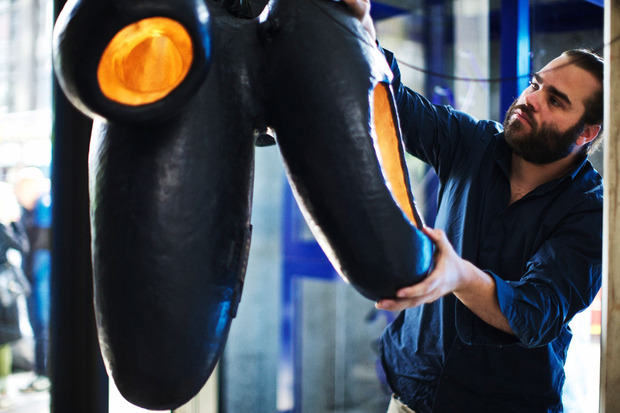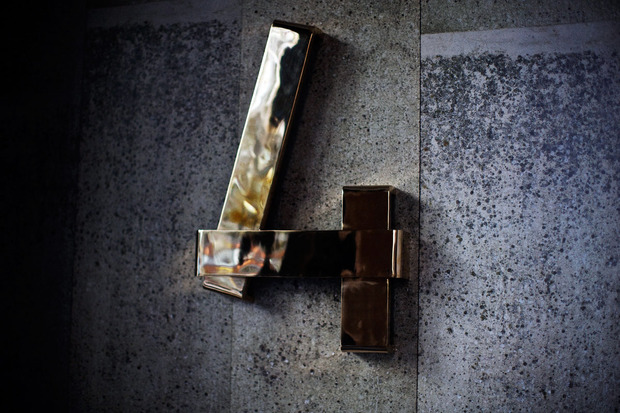Frederik Molenschot at Huys
The Dutch lighting designer’s public exhibition in a private residence in NYC


At the Huys (pronounced “house”) residence in New York City, presently in development by the Netherlands’ Kroonenberg Groep, you’ll find a new, unified showcase of Dutch contemporary design. Situated in an exhibition space, the lobby and beside every door, sculptural lighting designer Frederik-Molenschot has unveiled an imaginative public art exhibition and more. Among the work of the High Line’s landscape architect Piet Oudolf and world-class interior designer Piet Boon, Molenschot’s sculptures—some commissioned directly for Huys and some spanning further back in his career—provide a shimmering yet sturdy handcrafted artistry within the 1917, neoclassical building.
Molenschot is best known for his cast bronze lighting structures, which he hand-shapes into detailed formations to channel and direct light. The founder of Amsterdam-based Studio Molen, he is also a featured artist within Carpenters Workshop Gallery. His initial artistic explorations began as sculptures, but a shift in focus regarding the use of art brought him to lighting design. As he notes, lighting provided “an opportunity to tell a story behind what I make.” Inspired by both city lights and the night sky, his work embodies both natural and artificial structures as he foresees them in light of urban futurism. Stemming from his working relationship with Piet Boon, which began more than three years ago, Molenschot was brought on board at Huys in multiple capacities.

While he has designed a monumental chandelier for display at Huys, he has also installed a scaled version of it within the building’s public exhibition space—visible to any passerby or those seeking out his work. Surrounding the scaled chandelier, the entire space is furnished with Molenschot’s “ginger root” like art. The lobby also features a very large root-like bench. Each piece bears the attributes of “being left over by nature,” the artist explains. They each appear to be organic growths; something Molenschot was drawn to. The pieces are oftentimes paired, in various sizes, and blackened on the outside but with a refined brassy sheen within. It is a repurposing of organic growth, the way stones are rounded by nature or roots expand based on resource.
All of the featured Molenschot work is composed of cast bronze and he admires work crafted from “heavy stuff that one can turn fluid and solid again, like an egg you cook.” The works have an intriguing way of looking gentle and soft, while still carrying a roughness. Molenschot sought to demonstrate the roughness of the outside world: “My hands are rough, they’re not always clean. This is an organized roughness.”

A study of stones and nuts, trees and roots lead to an understanding of natural formations. And, by drawing upon the roughness of nature, Molenschot believes “You, as a viewer, can bring your own story to something natural. People need to be attracted to it.” There is a foreign familiarity that is entirely captivating.
In all of the light work on display, Molenschot has hidden the actual light source. The result is a glowing object, from which rays ruminate against the polished bronze insides. The effect adds to the nature-referencing vibe the sculptures emit. He refers to the process of tucking away the LEDs as “the golden dot on the i”—a Dutch phrase translating to a final flourish that shows attention to detail.
Perhaps the most modern attribute to every fixture: All of the lights are USB-powered. “It’s a small change but shows a big contrast from the way things used to be done,” the artist says. This subtle touch represents both the futurism and globalism Molenschot foresees, and then embeds in his work.

In addition to his lights and sculptures, Molenschot has even designed the brass door numbers that will be featured throughout the building. To arrive at the signage, he developed over 175 numerals before arriving upon each. Designed in his studio in Amsterdam, the residence’s signature number “4” has come to represent not only Molenschot’s contributions, but also the entire Dutch design team’s impact.
Regarding Huys, Molenschot believes that “as a designer this is a once in a lifetime opportunity to touch an entire building.” In so many ways, the building is a first attempt at binding Amsterdam aesthetics to NYC architecture. Molenschot’s work is on display at Huys, located on 404 Park Avenue South in New York City.
Images courtesy of Paul Barbera












